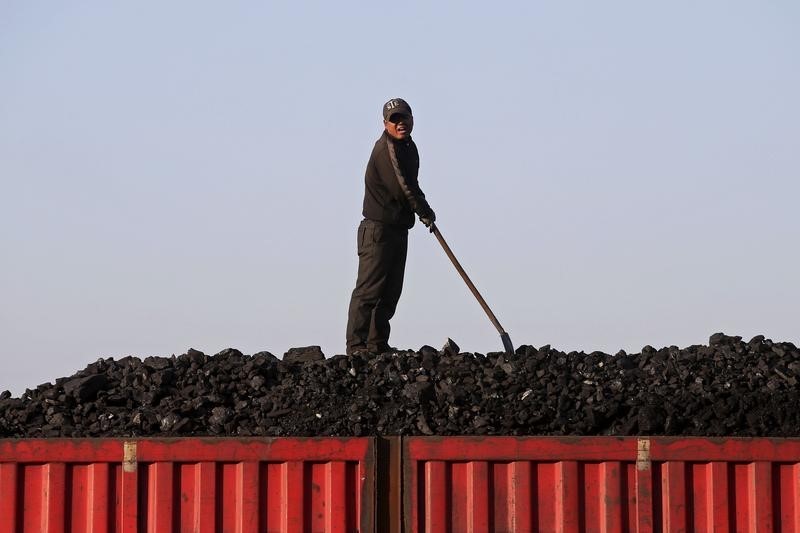(Repeats item issued earlier. The opinions expressed here are those of the author, a columnist for Reuters.)
By Clyde Russell
LAUNCESTON, Australia, April 26 (Reuters) - Australia and Russia could emerge the relative winners if China does restrict imports of North Korean coal, as it has pledged to do.
However, any time the word "if" appears in a sentence, it usually is the most important word.
The big "if" is whether China will act to decisively choke off one its nuclear-armed neighbour's biggest export earners, or whether Beijing will tolerate massive smuggling across the border, as has happened during previous sanctions-related trade bans.
China banned the importation of several minerals from North Korea on April 5, including coal, as part of new United Nations sanctions on Pyongyang aimed at curbing the rogue state's nuclear weapons programme. the North Koreans were maximising coal exports to China ahead of the ban, with Chinese customs data showing the country became the second-biggest supplier in March.
China imported 2.35 million tonnes from North Korea in March, an 80.6 percent leap from the same month in 2015, taking imports in the first quarter to 5.53 million tonnes, up 45.2 percent from the first quarter last year. from Australia rose 7.9 percent in March to 5.76 million tonnes, while those from third-ranked Indonesia dropped 12.1 percent to 2.33 million.
The breakdown of the import figures shows where winners and losers are likely to be found, assuming North Korea's exports drop dramatically from April onwards.
Virtually all of the coal North Korea supplies is anthracite, which is a higher-quality grade mainly used for power generation.
North Korea's share of China's anthracite's imports was 89 percent in March, and 88.6 percent for the first quarter, meaning it dominates this grade of coal.
The next biggest supplier was Russia, followed by Australia, with shares of 6.4 percent and 2.9 percent respectively.
Russia's first quarter exports of anthracite to China of 373,423 tonnes are 27.9 percent lower than for the same period last year, while Australia's are down by 49.6 percent.
This would imply that there is significant scope for those two countries to increase their anthracite exports to China if North Korea is knocked out of the market.
Russia would most likely be better placed, given it can ship more easily than Australia to northeast China, the destination of the bulk of North Korean coal exports.
It's not a given that the Chinese will simply replace North Korean anthracite with supplies from Russia and Australia.
Russian anthracite had a landed cost of $71.72 a tonne in March, while Australian supplies were $75, both of which are substantially more expensive than the $45.13 for North Korean coal.
This means it is also possible that Chinese customers will seek different grades of coal from anthracite to replace what they had been getting from North Korea.
But even if this is the case, assuming that Chinese buyers can't find suitable domestic coal, Russia and Australia are still better placed to supply higher quality coal than other competitors.
CHINA LOOKS FOR COAL QUALITY
Moving to higher quality does appear to be a theme in Chinese coal imports, with purchases of low-rank lignite dropping 14.8 percent to 4.56 million tonnes in March.
This is bad news for Indonesia, given its dominance in mining lower quality coal, with China importing 18.3 percent less from the Southeast Asian nation in the first quarter, compared with a year earlier.
China's ongoing efforts to restrict the use of polluting coal means this is a trend likely to continue.
This means that China is likely to lose its position as the world's top coal importer, and what imports it does buy will tend to be of higher quality.
China's National Energy Administration said on Monday that it would halt the construction of new coal-fired plants until 2018 in 15 regions, even for projects that have already been approved. also said that it will target for closure older, smaller power plants that don't meet efficiency and environmental standards.
This is further bad news for low-rank coal producers, as these smaller plants are more likely to use poorer quality fuels.
The other development worth noting in China's imports is the resurgence of coking coal, with Australia the main beneficiary.
Coking coal imports jumped 73.6 percent in March from the same month in 2015 to 5.09 million tonnes, and are now up 4.9 percent for the first quarter.
Australia's share of coking coal imports was almost 50 percent, and March saw a 66.3 percent jump, taking the gain to 12.9 percent for the first quarter.
Given China's steel output reached a record high in March, a boost to coking coal imports was expected, but perhaps the extent of the increase was a surprise, given that it was several times the magnitude of the 2.9 percent gain in March steel output.
It's likely re-stocking played some part in the leap in coking coal imports, which means the March jump was more than likely a one-off event.
However, if China's steel mills continue to produce at record levels, it does bode well for coking coal imports.
Like many other commodities, producers are now waiting to see whether China's increased appetite for natural resources is a temporary boost, or a more sustainable boost on the back of improved economic growth. (Editing by Richard Pullin)
